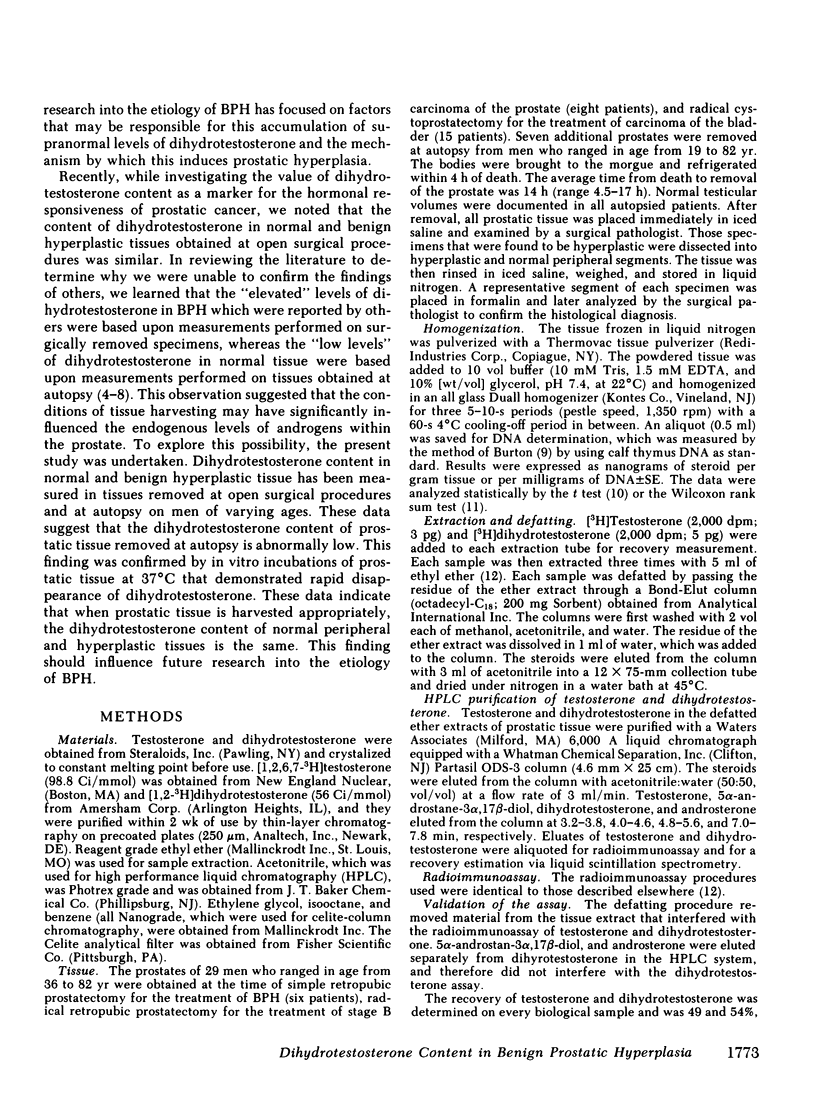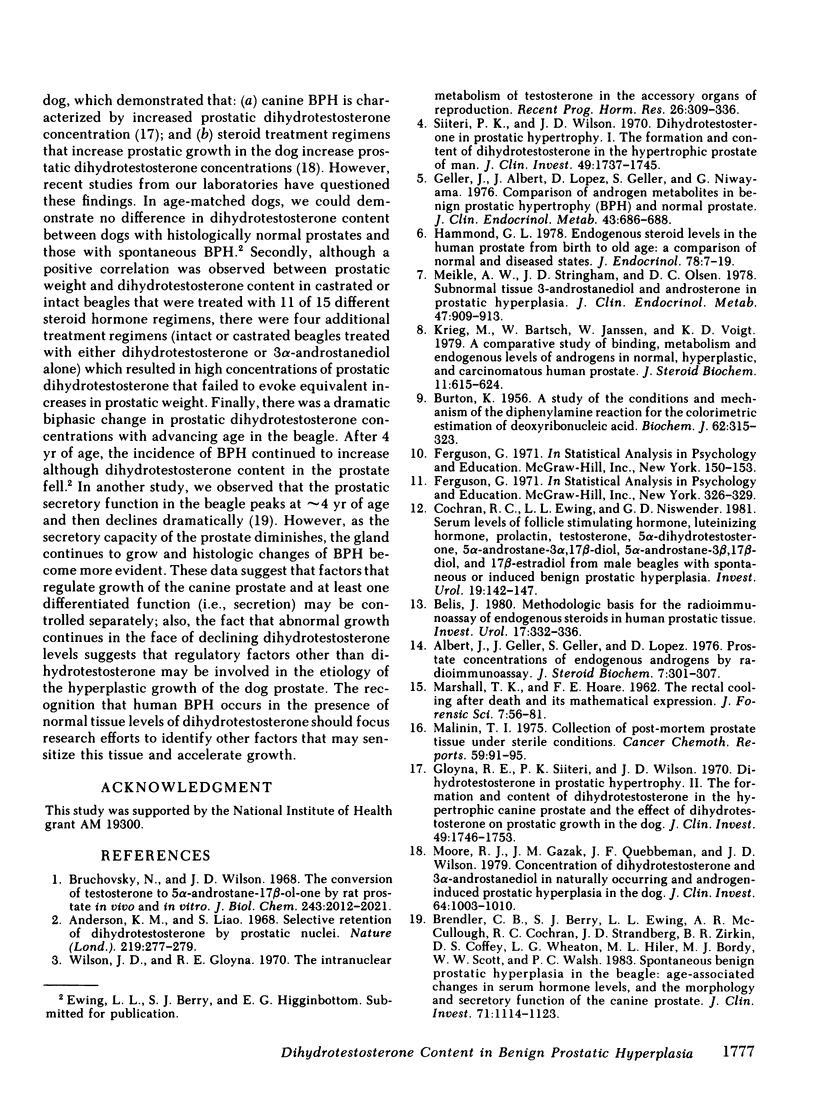Abstract
The dihydrotestosterone content of normal peripheral and benign hyperplastic prostates was measured in tissue obtained at open surgical procedures on 29 men of ages 36 to 82 yr. The dihydrotestosterone content in normal prostates (mean +/- SE, 5.1 +/- 0.4 ng/g tissue) and in benign hyperplastic prostates (5.0 +/- 0.4) was similar. In 11 patients in whom both normal and hyperplastic prostatic tissue was harvested simultaneously at the same operation, there was no significant difference in the content of dihydrotestosterone in the two types of tissue. These findings fail to confirm the widespread belief that dihydrotestosterone content is elevated in benign hyperplastic prostates. Our data differ from the reported literature in one major respect: the dihydrotestosterone content of normal peripheral prostate in this study is three to four times higher than previously reported. This difference between the present and earlier studies was resolved by experiments performed on cadavers, which were the source of normal prostatic tissue used by other investigators. Dihydrotestosterone content was measured in seven cadavers ranging in age from 19 to 82 yr of age. The results of this experiment indicate that the dihydrotestosterone content of prostatic tissue removed at autopsy is factitiously low (0.7-1.0 ng/g tissue). This finding was confirmed by in vitro incubations of fresh prostatic tissue at 37 degrees C that demonstrated reduction of dihydrotestosterone content to low levels within 2 h. When taken together, these results indicate that when prostatic tissue is harvested appropriately, the dihydrotestosterone content of normal peripheral and hyperplastic tissues is the same. This finding should influence future research into the etiology of benign prostatic hyperplasia.
Full text
PDF





Selected References
These references are in PubMed. This may not be the complete list of references from this article.
- Albert J., Geller J., Geller S., Lopez D. Prostate concentrations of endogenous androgens by radioimmunoassay. J Steroid Biochem. 1976 Apr;7(4):301–307. doi: 10.1016/0022-4731(76)90131-x. [DOI] [PubMed] [Google Scholar]
- Anderson K. M., Liao S. Selective retention of dihydrotestosterone by prostatic nuclei. Nature. 1968 Jul 20;219(5151):277–279. doi: 10.1038/219277a0. [DOI] [PubMed] [Google Scholar]
- BURTON K. A study of the conditions and mechanism of the diphenylamine reaction for the colorimetric estimation of deoxyribonucleic acid. Biochem J. 1956 Feb;62(2):315–323. doi: 10.1042/bj0620315. [DOI] [PMC free article] [PubMed] [Google Scholar]
- Belis J. A. Methodologic basis for the radioimmunoassay of endogenous steroids in human prostatic tissue. Invest Urol. 1980 Jan;17(4):332–336. [PubMed] [Google Scholar]
- Brendler C. B., Berry S. J., Ewing L. L., McCullough A. R., Cochran R. C., Strandberg J. D., Zirkin B. R., Coffey D. S., Wheaton L. G., Hiler M. L. Spontaneous benign prostatic hyperplasia in the beagle. Age-associated changes in serum hormone levels, and the morphology and secretory function of the canine prostate. J Clin Invest. 1983 May;71(5):1114–1123. doi: 10.1172/JCI110861. [DOI] [PMC free article] [PubMed] [Google Scholar]
- Bruchovsky N., Wilson J. D. The conversion of testosterone to 5-alpha-androstan-17-beta-ol-3-one by rat prostate in vivo and in vitro. J Biol Chem. 1968 Apr 25;243(8):2012–2021. [PubMed] [Google Scholar]
- Cochran R. C., Ewing L. L., Niswender G. D. Serum levels of follicle stimulating hormone, luteinizing hormone, prolactin, testosterone, 5 alpha-dihydrotestosterone, 5 alpha-androstane-3 alpha, 17 beta-diol, 5 alpha-androstane-3 beta, 17 beta-diol, and 17 beta-estradiol from male beagles with spontaneous or induced benign prostatic hyperplasia. Invest Urol. 1981 Nov;19(3):142–147. [PubMed] [Google Scholar]
- Geller J., Albert J., Lopez D., Geller S., Niwayama G. Comparison of androgen metabolites in benign prostatic hypertrophy (BPH) and normal prostate. J Clin Endocrinol Metab. 1976 Sep;43(3):686–688. doi: 10.1210/jcem-43-3-686. [DOI] [PubMed] [Google Scholar]
- Gloyna R. E., Siiteri P. K., Wilson J. D. Dihydrotestosterone in prostatic hypertrophy. II. The formation and content of dihydrotestosterone in the hypertrophic canine prostate and the effect of dihydrotestosterone on prostate growth in the dog. J Clin Invest. 1970 Sep;49(9):1746–1753. doi: 10.1172/JCI106392. [DOI] [PMC free article] [PubMed] [Google Scholar]
- Hammond G. L. Endogenous steroid levels in the human prostate from birth to old age: a comparison of normal and diseased tissues. J Endocrinol. 1978 Jul;78(1):7–19. doi: 10.1677/joe.0.0780007. [DOI] [PubMed] [Google Scholar]
- Krieg M., Bartsch W., Janssen W., Voigt K. D. A comparative study of binding, metabolism and endogenous levels of androgens in normal, hyperplastic and carcinomatous human prostate. J Steroid Biochem. 1979 Jul;11(1B):615–624. doi: 10.1016/0022-4731(79)90090-6. [DOI] [PubMed] [Google Scholar]
- Malinin T. I. Collection of postmortem prostate tissue under sterile conditions. Cancer Chemother Rep. 1975 Jan-Feb;59(1):91–95. [PubMed] [Google Scholar]
- Meikle A. W., Stringham J. D., Olsen D. C. Subnormal tissue 3 alpha-androstanediol and androsterone in prostatic hyperplasia. J Clin Endocrinol Metab. 1978 Oct;47(4):909–913. doi: 10.1210/jcem-47-4-909. [DOI] [PubMed] [Google Scholar]
- Moore R. J., Gazak J. M., Quebbeman J. F., Wilson J. D. Concentration of dihydrotestosterone and 3 alpha-androstanediol in naturally occurring and androgen-induced prostatic hyperplasia in the dog. J Clin Invest. 1979 Oct;64(4):1003–1010. doi: 10.1172/JCI109536. [DOI] [PMC free article] [PubMed] [Google Scholar]
- Siiteri P. K., Wilson J. D. Dihydrotestosterone in prostatic hypertrophy. I. The formation and content of dihydrotestosterone in the hypertrophic prostate of man. J Clin Invest. 1970 Sep;49(9):1737–1745. doi: 10.1172/JCI106391. [DOI] [PMC free article] [PubMed] [Google Scholar]
- Wilson J. D., Gloyna R. E. The intranuclear metabolism of testosterone in the accessory organs of reproduction. Recent Prog Horm Res. 1970;26:309–336. doi: 10.1016/b978-0-12-571126-5.50012-1. [DOI] [PubMed] [Google Scholar]


